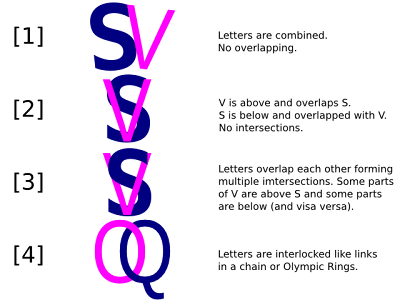A collage is a work of formal art, primarily in the visual arts, made from an assemblage of different forms, thus creating a new whole. [From Wikipedia, the free encyclopedia]
Abstract
Let's make a simple collage on sides of a cube (see Figure 0).For the simplicity, the same forms will be used for all visible sides of the cube in this tutorial.
 |
| Figure 0 - Tutorial Target |
Task and Decision
We have to create an isometric projection of a cube from its three plane unfolded sides filled with assembled forms (see Figure 0).
In isometric projection the three coordinate axes appear equally foreshortened and the angles between any two of them are 120 degrees. [From Wikipedia, the free encyclopedia]
We'll start with three unfolded cube sides. Then we'll import some images, assemble them in some way, and place the result on each side of the cube. Finally, we'll scale each side by cos 30, skew them by -30/30, and additionally rotate the top side by -30 to transform unfolded sides into the isometric projection.
Note
We'll use neither the Create 3D Box Tool nor the Axonometric Grid feature of Inkscape. We are going to add some design to plane sides of the cube and transform them along with their design.
Required Tools
- Selector
- Rectangle Tool
- Text Tool
Instructions
- Run Inkscape.
- Set the document size (File -> Document Properties...) to 500 x 500 px. Go to the Grids tab. Add a new rectangular grid and set spacing (both X and Y) to 50 px.
- Using the Rectangle Tool, draw a rectangle 250 x 250 px (5 x 5 grid cells) at the bottom left quarter of the page. Set the stroke width (Object -> Fill and Stroke...) to 1 px.
- Double the rectangle (Ctrl + D) twice. Using the Selector, move copies to the right and top keeping one side common with the original rectangle.
- Fill the rectangles with different colors, e.g. Lime, Aqua, and Yellow (see Figure 1). The simplest way to do so: select rectangles one by one with the Selector and choose the desired color from the Palette by clicking.
- Import (File -> Import...) the Open Book SVG image (see the Open Book tutorial). Scale it (File -> Transform...) proportionally by 13%. Otherwise you can use any other image or even just draw a circle, a rectangle, a star, or a spiral using Inkscape tools.
- Import the Interlocked Monogram SVG image (see the Interlocked Monogram tutorial). Scale it proportionally by 50%. Otherwise use any other image.
- Double the monogram. Flip the copy horizontal (Object -> Flip Horizontal). Move the copy close to the left page of the book and the original close to the right page.
- Holding SHIFT, select both monogram, then select the book. Align the selections (Object -> Align and Distribute...) relative to Last selected: center on horizontal axis and distribute centres equidistantly horizontally.
- Using the Text Tool, add some text at the top of the book, e.g. "Made with Inkscape, 2012". Play with fonts and size a bit. Set color to Maroon. Holding SHIFT, select the text, then the book. Align center on vertical axis.
- Holding SHIFT, select both monogram, the text, and the book. Group all four objects (Object -> Group).
- Double the group twice. Move the copies and the original close to the rectangles (one group per a rectangle).
- For each rectangle: holding SHIFT, select the group, then the rectangle; align center on vertical and horizontal axis; group the selections (see Figure 1).
- Scale the width of the bottom rectangles and the height of the top rectangle by 86.6% (cos 30). Adjust the rectangles so that one corner of each rectangle match the center of the document page (see Figure 1).
- Select the bottom left rectangle. Click the selection to toggle handles to the rotation mode. Drag the cross from the center of the selection exactly to the common corner of all rectangles (zooming will help). Holding CTRL, drag the selection by the middle left handle up to skew it by -30 (see Figure 1).
- Apply the Step 15 to the bottom right rectangle. This time, however, use the middle right handle and skew by 30.
- Apply the Step 15 to the top rectangle, but drag the middle top handle rightward and skew by 30 (see Figure 1).
- Holding CTRL, drag the top right handle of the top rectangle down to rotate the rectangle by -30 (see Figure 1).
- Save your work.
- Enjoy!
Summary
The idea of assembling different forms to create a new whole has been introduced in this tutorial. You can develop it according to your needs, preferences, and imagination.
Also the technique of creating an isometric projection of a cube has been explained and illustrated step-by-step.
The following operations have been used specifically:
- Doubling
- Filling
- Importing
- Scaling
- Flipping
- Aligning
- Grouping
- Zooming
- Skewing
- Rotating
Together, both skills you just learned are pretty good for various presentations, especially, of something 3-in-1.






